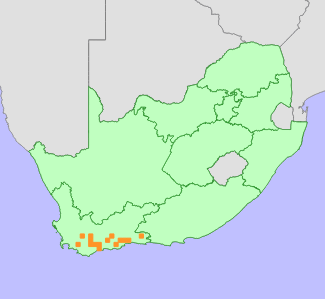|
Scientific Name | Pelargonium pilosellifolium (Eckl. & Zeyh.) Steud. |
Higher Classification | Dicotyledons |
Family | GERANIACEAE |
National Status |
Status and Criteria | Least Concern |
Assessment Date | 2018/06/07 |
Assessor(s) | L. von Staden |
Justification | Pelargonium pilosellifolium is a widespread species, with an extent of occurrence (EOO) of 18 531 km². It is threatened across most of its range, but not yet in danger of extinction. It is therefore listed as Least Concern. |
Distribution |
Endemism | South African endemic |
Provincial distribution | Western Cape |
Range | This species is endemic to South Africa, and is found from Riviersonderend Mountains, Keeromsberg and Potberg eastwards along the mountains of the southern Cape to the western footslopes of the Kouga Mountains near Uniondale. |
Habitat and Ecology |
Major system | Terrestrial |
Major habitats | Western Altimontane Sandstone Fynbos, Garden Route Shale Fynbos, North Sonderend Sandstone Fynbos, South Sonderend Sandstone Fynbos, North Langeberg Sandstone Fynbos, South Langeberg Sandstone Fynbos, Potberg Sandstone Fynbos, North Outeniqua Sandstone Fynbos, South Outeniqua Sandstone Fynbos, Swellendam Silcrete Fynbos, Kouga Sandstone Fynbos, Breede Shale Renosterveld, South Hex Sandstone Fynbos, Western Ruens Shale Renosterveld, Central Ruens Shale Renosterveld, Eastern Ruens Shale Renosterveld, Mossel Bay Shale Renosterveld, Langkloof Shale Renosterveld, Matjiesfontein Shale Renosterveld, Montagu Shale Renosterveld, South Rooiberg Sandstone Fynbos |
Description | It occurs on lower slopes at sandstone-shale ecotones. |
Threats |
| Pelargonium pilosellifolium has lost some of its habitat to crop cultivation in the Overberg and Langkloof. Around George, Suurbraak and Greyton it has lost habitat to timber plantations in the past, and are now threatened by spreading, unmanaged infestations of escaped pine seedlings that are outcompeting native species. |
Population |
There is no information available on the population of this species.
|
Population trend | Decreasing |
Assessment History |
Taxon assessed |
Status and Criteria |
Citation/Red List version | | Pelargonium pilosellifolium (Eckl. & Zeyh.) Steud. | Least Concern | Raimondo et al. (2009) | |
Bibliography |
Manning, J.C. and Goldblatt, P. 2012. Plants of the Greater Cape Floristic Region 1: The Core Cape Flora. Strelitzia 29. South African National Biodiversity Institute, Pretoria.
Marais, E.M. 1994. Taxonomic studies in Pelargonium, section Hoarea (Geraniaceae). Unpublished Ph.D. Thesis, University of Stellenbosch, Stellenbosch.
Raimondo, D., von Staden, L., Foden, W., Victor, J.E., Helme, N.A., Turner, R.C., Kamundi, D.A. and Manyama, P.A. 2009. Red List of South African Plants. Strelitzia 25. South African National Biodiversity Institute, Pretoria.
Snijman, D.A. 2013. Plants of the Greater Cape Floristic Region 2: The extra Cape flora. Strelitzia 30. South African National Biodiversity Institute, Pretoria.
|
Citation |
| von Staden, L. 2018. Pelargonium pilosellifolium (Eckl. & Zeyh.) Steud. National Assessment: Red List of South African Plants version 2024.1. Accessed on 2025/12/12 |
 Comment on this assessment
Comment on this assessment


